Facing Peace of Mind: Loving Communications

By Marya Mann, Ph. D.
Communication is a bridge that connects us. When we seek to solve a problem or explore an idea or make a suggestion to someone, why and how we speak affects how others receive us –-whether they are uplifted or defeated, charmed or horrified, exquisitely peaceful, or in comic terms, inadvertently “peesed off” for what we’ve just said.
We’ve all heard variations on misunderstood communications: “Why do you always put me down?” Or “You always take the things I say the wrong way!”
I’m not talking here about sales messaging or business negotiations – which too often are guided by greed — this is about Loving Communications, defined as messages intended and expressing love and connection by people who are aware, aligned and clear of their intent. In Loving Communications, we’re aiming at what unites us, not what gives the communicator benefit by exploiting or misleading the receiver. I know it’s a novel idea, and sad. What if we aimed at uplifting each other? To have Loving Communications that actually produce a holy communion, we must feel our common ground of being, a quickening of our mutual divinity. Loving Communications are poetry for social well-being, moving beyond the high school prom and complicated dramatics of dysfunctional families.
The family or group that is FUNctional consists of individuals who make simple transmissions without a lot of ego aggrandizement. Your message is the astonishing crest of the wave of evolution of our species. Machines have turned us into cyborgs, right under our noses, our I-Pad-seeking fingertips and inside our ear-budded heads.
That’s only what we can see! We walk, dance, talk and swim in an unseen world of extremely low-frequency waves, at every latitude and in every attitude, vibrations of sound and light massage our cells.
Here we are together in the one atmosphere which is beyond any one person’s control, hoping with our hearts open and our minds clear, that we can connect. We hope the speed and polish of technology — which we’re basically relying on now to make up new body parts! — will extend into space and connect us even more extensively.
We’re already connected, as any sensitive person will let you know.
People come to any exchange of energy and information with variables totally out of their control. First, other people may not always feel well. They may have just lost a pet rock or had a colonic. Or they may not have heard you correctly! They – or their unconscious mind, may even want to contradict your intent because they’re angry or upset about something else from the past, from 200 years ago, or grieving for some tremendous tragedy, Super Bowl loss and global warming. Maybe they just lost their dog, or house, or the water hose on their car. They may not even wish to be nice, so hateful are they about something beyond your control. They don’t understand you, and don’t care to, because they’re thinking about something else. Or they’ve been hurt and want to unload their pain by blaming you. This is humanity’s plight of suffering until we choose differently: we all do it.
And yet everyone wants to connect and stay connected because we know that wholehearted connections nourish us at the deepest levels. With them, we thrive. Without them, we wither.
We can deepen our relationships with ourselves and with others by exploring differing rules of communication and by looking to nature, specifically flowers. Noble irises, bouncy bougainvillea and sweet pansies, for instance. See how flowers grow under one sun, rise up in a bountiful, colorful array and share one common underground where their roots are all connected.
Yet every local culture has rules of communication which vary enormously. They are like languages. In each part of the world unique ways of conversing and sharing discoveries, joys, hurts and dreams developed. Over time, these customs became either tacit or spoken agreements about what constitutes healthy communication.
Some rules of communication may inhibit the human connections that we desire. They may actually harm us or others, but we don’t see it because of those cultural blinders. We all have them. They’re like a cultural lens, a trance state that’s never questioned. Rules of communication involve spoken language, body language and ritual language.
In some cultures it’s disrespectful to make eye contact, for instance. If a Japanese woman avoids looking someone in the eyes, she is usually not showing a lack of interest, nor is she demonstrating a lack of self-confidence. Instead, according to her culture, she is being polite, respectful and appropriate.
In many Asian, African and Latin American cultures, extended eye contact might be considered an affront or a challenge to authority. It’s considered more well-mannered to have only sporadic or brief eye contact, especially between people of different social registers (like a student and a teacher, or a child and his elder relatives). Loving Communications invites you to watch what kind of eye contact people prefer, and to be flexible. Especially with those who believe they are socially superior, which is everybody, and with those who believe they’re inferior, which is everybody.
European customs of eye contact—especially in such countries as Spain, France and Germany—tend to be similar to those in the United States. It’s quite proper and polite to maintain almost constant eye contact with another person during a business exchange or a conversation.
Culturally-accepted personal space boundaries also differ among groups. Europeans tend to stand much closer to the person they’re speaking with, for example, Knowing when and where to stand, as well as where to look, shows a polite, responsive attitude which can make the difference between making new friends and triggering a turn-off.
Of course that’s what many communication strictures are for – to turn off or prevent actual communication, to blinder us. When the printed word came into existence, many leaders fought it because they didn’t want their subjects having conversations they couldn’t control. When TV and the internet came into our lives, same thing: totalitarian-type authorities obstructed the free flow of communication. They didn’t want fresh insight interfering with pre-approved customs and beliefs, baffling as they might be.
While making some eye contact may be the standard for Westerners, it’s still difficult for some. A recent study from the British cognitive psychologist Dr. Peter Hills found that sad people often avoid eye contact but happy people actively seek to look in the eyes of others. Avoiding eye contact leads to social isolation, which increases depression, which leads to poor eye contact. It’s a vicious cycle which can be turned into a delicious cycle: eye gazing increases levels of the love hormone oxytocin and anti-anxiety neurotransmitters like serotonin and dopamine. Love and peace are powerful energies that can heal, motivate and ignite creative sparks.
In contemporary energy medicine, psychotherapy and trauma release, deep and loving eye gazing is often vital in restoring a beneficial bond between someone who is hurting and someone who can help. Any artist – whether a dancer, writer or painter — uses the visual sense more than any other to see clearly and deeply before shaping a new reality with their feet, hands, pen or paintbrush.
Humility is one of the traits I admire most. Faced with someone from a culture or a situation I don’t understand, I accept the uncertainty. I listen and look to see: is this situation rooted like the flowers in common ground, compassion and partnership, or on domination and intrigue? How can I develop rapport with this person or group without negating or belittling my own culture, customs and needs? Do I even want to?
Taking time to be a good steward of relationships and to understand multi-cultural rules and values of communication helps us to be proper caretakers of our planet. It can also give us countless opportunities for humor.
But be careful, humor’s beautiful sister – the smile — often assumed to be a universally clear, non-verbal communication, is not the same all over the world: in Japan, a smile can mean someone is sad or distressed. In any culture, a smile expresses emotions that can be mixed.
In turning the corners of the mouth up, activating only the zygomaticus major muscle (near the mouth), the smile may show pleasure or amusement, but not genuine emotion. The “Duchenne smile,” named after Guillaume Duchenne, involves the stereotyped movement of the zygomaticus major muscle (near the mouth) and the orbicularis oculi muscle (near the eyes). That kind of smile, radiating from all over the face and from the eyes, is a good sign you’re seeing an honest feeing, as it’s not easy to fake.
The mouth-only smile is somewhat forced. Its aptly-named the “Pan American smile” after the forced politeness of a flight attendants, a stereotype it’s true, but also sometimes accurate.
We’ll never know the full extent of each other, for humans are too complicated by nature and culture to ever know the full extent of our cultural trances, beliefs and unexamined assumptions. What we can do is choose to approach our relationships with an expectation of the best, a healthy dose of tolerance, and an open mind. With optimism and candor, allowing the gifts of uncertainty and the treasures of harmony to arise, we grow. Frozen by customs and unexamined beliefs, we cannot thrive.
As Lily Tomlin said, an open mind is like a Mexican piñata. “There’s a lot of surprises inside, once you get the piñata perspective.” Allowing ourselves to really connect, to receive new information and energy, we can transform ourselves and be surprised and delighted by a society as beautiful as the flowers, with their vast, wonderful diversities and sweet scents on the breeze.
@@@@@@@@@@@@
“Your task is not to seek for love, but merely to seek and find all the barriers within yourself that you have built against it.” — Rumi
@@@@@@@@
VITAL! Accelerated Wellness – QUANTUM HEALING
Riding the Quantum Wave FUNction
Marya Mann is a leader in cutting-edge education and creative mentoring using yoga, brain science, mindfulness, the creative arts, trauma recovery and mind body medicine in a set of methods known as Quantum Leap Creativity, the title of her forthcoming book, and Quantum Healing, Quantum Relationships and special topics in Miracle Physics.
Founder of Kona Coast Wellness, she is an accomplished author, speaker, dancer, yoga teacher and wellness consultant with over 30 years experience facilitating communication, organizational and personal creativity and a new eco-health paradigm. She specializes in assisting individuals, couples and groups in creating the ideal media for Loving Communications and deeper connections for the health and harmony of our planet.
For more information, call (808) 328-0171 or visit www.maryamann.com
Kona Coast Wellness was created with the client, student and adventurer in mind. With love for the physical practice of yoga, the stories of Hawai’i Island and the dance shared in hula and movement meditations, sessions are conducted in a non-competitive environment, by the sea, in the flow of nature.
Providing Yoga Dance, Quantum Healing and Conscious Consulting to help you restore authentic alignment in body, mind, heart and spirit.
One session can still change your life for the better, forever.
CLASSES, WORKSHOPS AND SESSIONS:
In Office or Phone Sessions:
Quantum Healing Sessions – 1 – 1.5 hour
PSYCH-K – Life-Changing Belief Point Integration – 1 – 1/5 hour
On Kona Beaches:
Introductory Yoga Stretch – Breathe, Tone and Sculpt
Yoga Dance – Ethnic Fusion Fun
Touch with Intention – Yoga Massage
Studio Classes:
Acu-Yoga for Pain Relief Starting in March
Yoga Deep Stretch – Call for Class Times
NEXT YOGA DANCE ARTS TEACHER TRAINING IN NOVEMBER, 2014
To contact Dr. Mann, please click here
For more information, call 808-328-0171.


